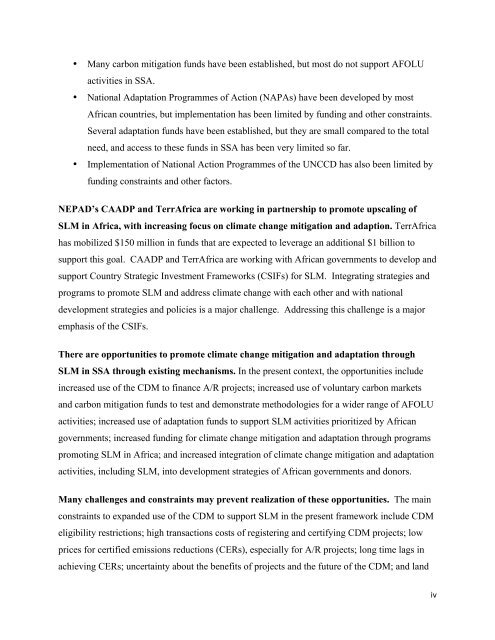The Role of Sustainable Land Management for Climate ... - CAADP
The Role of Sustainable Land Management for Climate ... - CAADP
The Role of Sustainable Land Management for Climate ... - CAADP
You also want an ePaper? Increase the reach of your titles
YUMPU automatically turns print PDFs into web optimized ePapers that Google loves.
!<br />
• Many carbon mitigation funds have been established, but most do not support AFOLU<br />
activities in SSA.<br />
• National Adaptation Programmes <strong>of</strong> Action (NAPAs) have been developed by most<br />
African countries, but implementation has been limited by funding and other constraints.<br />
Several adaptation funds have been established, but they are small compared to the total<br />
need, and access to these funds in SSA has been very limited so far.<br />
• Implementation <strong>of</strong> National Action Programmes <strong>of</strong> the UNCCD has also been limited by<br />
funding constraints and other factors.<br />
NEPAD’s <strong>CAADP</strong> and TerrAfrica are working in partnership to promote upscaling <strong>of</strong><br />
SLM in Africa, with increasing focus on climate change mitigation and adaption. TerrAfrica<br />
has mobilized $150 million in funds that are expected to leverage an additional $1 billion to<br />
support this goal. <strong>CAADP</strong> and TerrAfrica are working with African governments to develop and<br />
support Country Strategic Investment Frameworks (CSIFs) <strong>for</strong> SLM. Integrating strategies and<br />
programs to promote SLM and address climate change with each other and with national<br />
development strategies and policies is a major challenge. Addressing this challenge is a major<br />
emphasis <strong>of</strong> the CSIFs.<br />
<strong>The</strong>re are opportunities to promote climate change mitigation and adaptation through<br />
SLM in SSA through existing mechanisms. In the present context, the opportunities include<br />
increased use <strong>of</strong> the CDM to finance A/R projects; increased use <strong>of</strong> voluntary carbon markets<br />
and carbon mitigation funds to test and demonstrate methodologies <strong>for</strong> a wider range <strong>of</strong> AFOLU<br />
activities; increased use <strong>of</strong> adaptation funds to support SLM activities prioritized by African<br />
governments; increased funding <strong>for</strong> climate change mitigation and adaptation through programs<br />
promoting SLM in Africa; and increased integration <strong>of</strong> climate change mitigation and adaptation<br />
activities, including SLM, into development strategies <strong>of</strong> African governments and donors.<br />
Many challenges and constraints may prevent realization <strong>of</strong> these opportunities. <strong>The</strong> main<br />
constraints to expanded use <strong>of</strong> the CDM to support SLM in the present framework include CDM<br />
eligibility restrictions; high transactions costs <strong>of</strong> registering and certifying CDM projects; low<br />
prices <strong>for</strong> certified emissions reductions (CERs), especially <strong>for</strong> A/R projects; long time lags in<br />
achieving CERs; uncertainty about the benefits <strong>of</strong> projects and the future <strong>of</strong> the CDM; and land<br />
!<br />
"#!

















